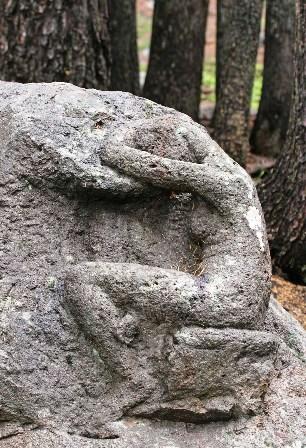Lady of the Woods is the figure of a woman carved from a large volcanic boulder in Crater Lake National Park. The carver was Dr. Earl Russell Bush, a physician working for the Corps of Engineers, in October of 1917.
The Corps of Engineers was supervising work crews constructing a road to and around the rim of Crater Lake. Work was based out of a permanent camp at the head of Munson Valley with a few rustic log cabins and tents for shelter. Work for the season was coming to an end and Dr. Bush had a few short weeks to fill. He had convinced the blacksmith to build a set of tools for carving and he had chosen a volcanic rock a few hundred feet from the Munson Valley camp, within the mountain hemlock forest.
Although Dr. Bush worked on the carving just 11 days (October 4-15), it would be several more years until the complete story of its creation would be known by the public.
Interestingly, it was only William Steel, the father of Crater Lake National Park. and Alex Sparrow, the park superintendent, who were privy to Dr. Bush's creation. In 1921, the full story appeared in local papers, however, regional papers occasionally reported false accounts of it's origin, with such titles as, Ancient figure of woman discovered (Oregon Journal, 1919) and Mummy woman found in woods at Crater Lake (Medford Mail Tribune, 1919).
In 1925, Mr. Steel published the complete story and, with demand to see the carving steadily growing, a trail was constructed from park headquarters to the Lady of the Woods, in 1930. The first thorough history of Lady of the Woods and an account of Dr. Bush's 1954 visit to Crater Lake NP (Dr. Bush had not seen Lady of the Woods since 1917), appeared in Nature Notes From Crater Lake (Lady of the Woods Revisited, Vol. 21, 1955).
The context surrounding Dr. Bush's first sculptural effort is interesting as momentous changes were under way for the United States, the National Park Service, and Crater Lake National Park. Just six months before Dr. Bush began his carving, the United States had declared war on Germany and entered a war already raging for three years on the European continent.
In that same month, Stephen Mather was appointed the first director of the newly created National Park Service. This began a 23-year-reign for Stephen Mather and his assistant, Horace Albright, who would eventually succeed him. This dynamic pair of men would consolidate the national parks into a cohesive unit and begin a massive parks promotional campaign.
Ironically, it was William Steel, the one person who had been so instrumental in obtaining park status for Crater Lake National Park, who resigned as park superintendent in 1916 and turned the park over to Alex Sparrow, one of the first of many "Mather Men," as the Mather-appointed superintendents would come to be called.
It was William Steel who went to Congress for money to begin the first survey and construction of the park roads. He also had an influential hand in the construction of the Crater Lake Lodge two years earlier. However, Mr. Steel knew there was no room for him in the new park system and, so, his leadership position in the park was over.
So, it was in the shadow of these changes Dr. Bush chipped away at a volcanic rock to create his homage to the natural beauty of Crater Lake. He was quoted in a 1921 article:
This statue represents my offering to the forest, my interpretation of its awful stillness and repose, its beauty, fascination, and unseen life. A deep love of this virgin wilderness has fastened itself upon me and remains today. It seemed that I must leave something behind .... if it arouses thought in those who see it, I shall be amply repaid. I shall be satisfied to leave my feeble attempt at sculptural expression alone and unmarked, for those who may happen to see it and who may find food for thought along the lines it arouses in them individually. It would be sacrilege to assign a title and decorate it with a brass plate.
Traveler trivia: Dr. Bush's sculpture was given the name, Lady of the Woods, a few years later by Fred Kiser, the self-proclaimed "official photographer of Crater Lake National Park" who was another tireless promoter of the park and self-promoter of his own works. He had a photographic studio at the rim of the lake, not far from the Crater Lake Lodge. This studio is now the Rim Village Visitor Center.
The Lady of the Woods is located on the Park Headquarters Historic Trail. The trailhead is just behind the Steel Visitor Center. Expect snow on the trail from mid-October until mid-June. In winter, the carving may be partially or completely covered.
You can find more information at the Crater Lake Institute website.




Comments
Thanks Rob for sharing this excellent article and photograph.
Owen Hoffman
Oak Ridge, TN 37830
Sure, Owen. Lady of the Woods is a wonderfully unique feature that helps give Crater Lake National Park it's special character. The park is a fantastic mix of natural and cultural history.
rob
---
Executive Director,
Crater Lake Institute
www.craterlakeinstitute.com
Robert Mutch Photography